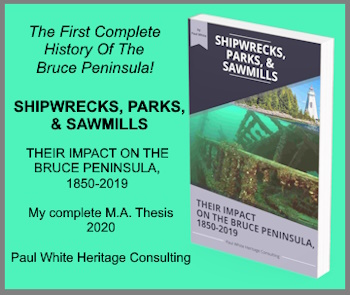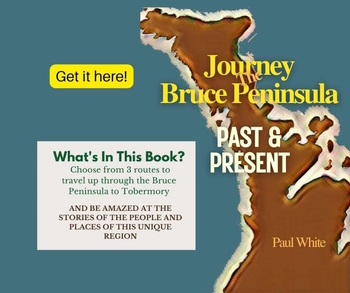My newest book, "Hockey In The Forest City: London's Story" SEE IT HERE!
Hepworth Ontario:
The Early History
Hepworth Ontario's early history is tied to two essential commodities, sawmilling and transportation. How Hepworth got its name is also an interesting story.
Amabel Township is a special place in our family. My great-great-grandfather David Forsyth was the first settler there, and his daughter, Victoria, was the first non-native child born on the Bruce Peninsula. My grandmother was born in the original farmhouse that her grandfather built.
On Oct. 13, 1854, a treaty was signed with the Saugeen Indigenous peoples, purchasing a vast tract of land for future settlement. On August 26, 1855, the public land surveyor, Charles Rankin of Owen Sound, was instructed by the Crown to survey the townships of Amabel and Keppel. One year later, on November 20, an auction sale was held in Owen Sound for the purpose of the dispersal of this land. A Brief History of the Communities of Amabel Township written in 1961 in celebration of the centennial of that Bruce County township reveals that "over 100,000 lots were sold, at an average price of 18s 6p or about $4.45 per acre."
Unfortunately, most of the land had fallen into the hands of speculators and only a few settlers actually carne to establish homesteads. By 1861, when the township was incorporated the first assessment rolls contained only 63 names with an assessment of $21,600.
Amabel's first post office was built in Elsinore. A short distance from Elsinore on "B" Line, the first school was built in 1863 on my great-great-grandfather's farm. The first teacher, Mr. Burr, could always count on the Forsyth children being at school no matter what the weather. Imagine the indignation my great-grandfather and his sisters and brothers must have felt about having school so close. It must have been almost impossible for them to cut classes!
In 1862, William Spencer bought approximately 200 acres about where Highway #6 leaves Highway #70 and heads towards Wiarton. In 1865, Spencer was elected to the municipal government of the district. This municipality included Arran and Amabel townships and all the territory on the peninsula to Tobermory.
Using his influence on the council, Spencer was able to lead the way in establishing a village, which later became Hepworth. Spencer then built one of area’s first inns at what is now the intersection highways #6 and #70. In 1867, William Plows opened another inn and the community continued to grow, Plows and Spencer decided to call it "Epworth" after the town in England where they had both grown up. In 1870, a post office with Spencer as the postmaster, was established.
Amabel Township was originally heavily forested, and the trees had to be cleared to enable the settlers to farm Therefore, it is not surprising that sawmilling, and other lumbering activities, constituted a major commercial activity. In 1862 a sawmill was erected at Sauble Falls. In 1866, Pickard and Bowan built a sawmill near Hepworth. Sawmilling remained a commercial mainstay of that community for decades.
In the 1880s, when a railroad line was built to Wiarton, care was taken to ensure rail service for Hepworth to enable the efficient shipment of logs to the port of Wiarton.
Transportation links have always been an important aspect to Hepworth's economy. This remains true today, as Hepworth is a link for travellers heading to Sauble Beach to west, and to north, to Wiarton, Tobermory and the rest of the Bruce Peninsula.
A version of "Hepworth Ontario: The Early History," originally appeared in my Local History column in the November 11, 1995 edition of the Owen Sound Sun Times.
Bruce Peninsula Towns & Villages
Towns & Villages: The first Bruce Peninsula towns and villages had a source of water power to run sawmills and a good harbour to ship forestry products to market.
The 12th of July and Dominion Day Celebrations on the Bruce Peninsula were an outlet from the everyday drudgery of life for pioneers on the Bruce Peninsula.
Allenford United Church history details some important information about that community's church but also about one of the founders of this Ontario community.
A Pioneer Community: Driftwood Crossing (now Allenford): at the southern-most part of the Saugeen/Bruce Peninsula was at the midpoint between the Georgian Bay and Lake Huron coasts.
Land Auction in Amabel Township provided the opportunity for settlers to purchase land and begin a new life in Bruce County. On July 18, 1856, a notice signed by R.T. Pennefather, superintendent general the Indian Department, announced the public auction sale of 144,000 acres of land in the new townships of Amabel and Keppel.
Barrow Bay Ontario: a Picturesque Georgian Bay Community owes its origin to the once-thriving Bruce Peninsula lumbering industry. Today it is a quiet summer get-away!
Bruce Peninsula Municipal Politics: No matter what the venue, or the issue, seldom is a decision made that suits everyone.
Bruce Peninsula Newspapers Rivalry between the Wiarton Echo and Owen Sound newspapers promoting their communities was often vitriolic and led to acrimony between the two communities.
Dyer's Bay Ontario: Began as a lumbering settlement but may also have been one of the earliest points on the Bruce Peninsula to be visited by French explorers.
Elsinore Ontario: In the mid-1850s the first settlers arrived in the area just west of Allenford. However, it was not until 1865 when the North Gravel Road, or Highway 21 as it known today, was built that the village of Elsinore was established.
Hepworth Ontario: The early history of Hepworth is tied to two essential commodities, sawmilling and transportation. How Hepworth got its name is also an interesting story.
Lion's Head remained an important lumbering centre into the twentieth century. Today it is a centre of tourism, and the lion's head still guards the southern entrance to the bay. However, the same elements that created the image have continued to erode the rocky outcropping.
Park Head was an important Grand Trunk Railway depot on the Bruce Peninsula.
Sauble Beach: This popular beach in the 1950s was called Canada's Daytona Beach.
Sauble Beach Ontario is one of the most popular summer resorts in the province of Ontario. It welcomed its first summer visitors in the late 1800s and as continued to grow in popularity since that time.
Stokes Bay welcomed fishermen as their first non-native visitors. Today, if you are a fisherman, you will also probably want to try your luck landing a walleye, lake trout or any of the other game fish that live in the coastal waters of Lake Huron.
Tobermory Ontario has a rich history and, is the northern- most destination point for travellers visiting the world famous Bruce Peninsula.
Tobermory Ontario Tourism is focused on Fathom Five National Marine Park, Bruce Peninsula National Park, and, shipwreck diving which has become so popular that tourism has become an important part of that community's economy.
Tobermory Pioneers were first the fishermen who came to reap the rewards of the fishing-rich waters at the top of the peninsula.
Tupper Murray was one of the first names given to the community at the top of the Bruce Peninsula
Wiarton Ontario was known for its excellent natural harbour. It seemed to be a natural choice for the location of a port community. Colpoys Bay offered a natural harbour refuge for sailing vessels from storms on the often-tumultuous waters of Georgian Bay. As well, the harbour was located at the portage route across the base of the Bruce ...
Wiarton had Ambitions to Succeed but while success brought them a railroad and other ventures, one attempt did not have a sweet ending for many in the town.
Wiarton News: 1897 Town Council Report. By 1897 Wiarton was an established community and was experiencing some of the growing pains consistent with a community which was constantly expanding its physical borders. A November 1897 Wiarton council meeting reveals some the problems which that community was facing.
Wiarton Beet Industry: Wiarton's Sweet Enterprise Turns Sour! In their attempts to diversify Wiarton's economic base, a dramatic new industry was incorporated in 1896. Originally called the Owen Sound Sugar Manufacturing Company, the Wiarton Beet Sugar Manufacturing Company looked like it would have a large impact on the economy of the Wiarton area.
Wiarton Ontario's First Newspaper: The Echo viewed itself not only as a messenger of the news of the day, but also as a medium to promote the development of the interests of the Bruce Peninsula, and more particularly those of Wiarton.






